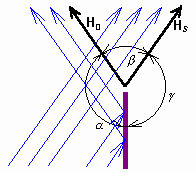2.4 Geometric theory of diffractionBasic theoryGeometrical optics is a proper method for computing wave propagation in homogeneous media or in the environment exhibiting a continuous variation of parameters. If the environment contains objects, the method fails.
Look at the fig. 2.4A.1. We can observe the situation in the surrounding of an illuminated reflecting half-plane from the point of view of geometrical optics. The space around the half-plane can be subdivided into three sections: into the section a, where both the incident wave and the reflected one are present, into the section b, which contains the incident wave only, and to the section l, where no wave (from the point of view of geometrical optics) propagates. Moreover, exactly defined planes H0 (border of reflection) and HS (border of shade) separate the sections. From the point of view of geometrical optics, a discontinuity of the field distribution appears on those planes because on different sides of H0 and HS, intensity is computed in a different way. In real world, the field distribution is continuous, and in the section of shade, intensity is non-zero. In the sixties of 20th century, Keller proposed a specific correction of geometrical optics in order to eliminate field discontinuities in the surrounding of objects. That way, the basics of the geometric theory of diffractionwere built. Geometric theory of diffraction (GTD) is an extension of geometrical optics to inhomogeneous media. GTD solves interaction of beams and objects according to the laws of geometrical optics, which is completed that way to eliminate obvious incorrectness (intensity discontinuities at the border of the reflection section and the shade one) and to preserve the main advantages of geometrical optics (conception of beams). The incorrectness of geometric optics is eliminated following the below-described postulates:
In fig. 2.4A.2a, arrows indicate diffraction waves excited by an incident wave illuminating the edge of the half-plane. Diffraction waves create the set of cylindrical waves, which common source is the half-plane edge. Adding incident and reflected wave together, continuous intensity transitions on the border of the reflection region and the shade one is ensured. In fig. 2.4A.2b, beams of diffraction waves excited by the incident wave beam are depicted for the situation when the beam touches the object surface. In the moment when the beam of the diffraction wave leaves the object surface, it starts to behave according to the geometric optics rules. Finally, the postulate about the local parameters of objects is very important. In the situation of fig. 2.4A.2b, the diffraction factor is given by parameters e, m of the object surface and by the curvature radius of the surface in the region, where the beam slides (over the surface. Parameters of the rest of the object do not play any role. Thanks to this property, even complicated diffraction situations appearing in a real terrain can be solved (fig. 2.4A.2c).
Thanks to the above-mentioned postulate, values of diffraction factors can be computed. E.g., all the oblong objects, which have the same curvature radius of a certain part of their surface, have the same diffraction factor. The factor has to be the same as for the cylinder of the same radius. And the diffraction on a cylinder can be solved exactly. We only have to rearrange the results of the exact theory (see the chapter 2.2) to the form applicable to the theory of geometric optics. This is solved by so called canonical problems. GTD is together with geometrical optics an efficient tool for solving diffraction problems. Preserving the conception of beams and computing with local object properties are the main advantages of the method. The method has to be implemented using computer. | |||||||||||||||

